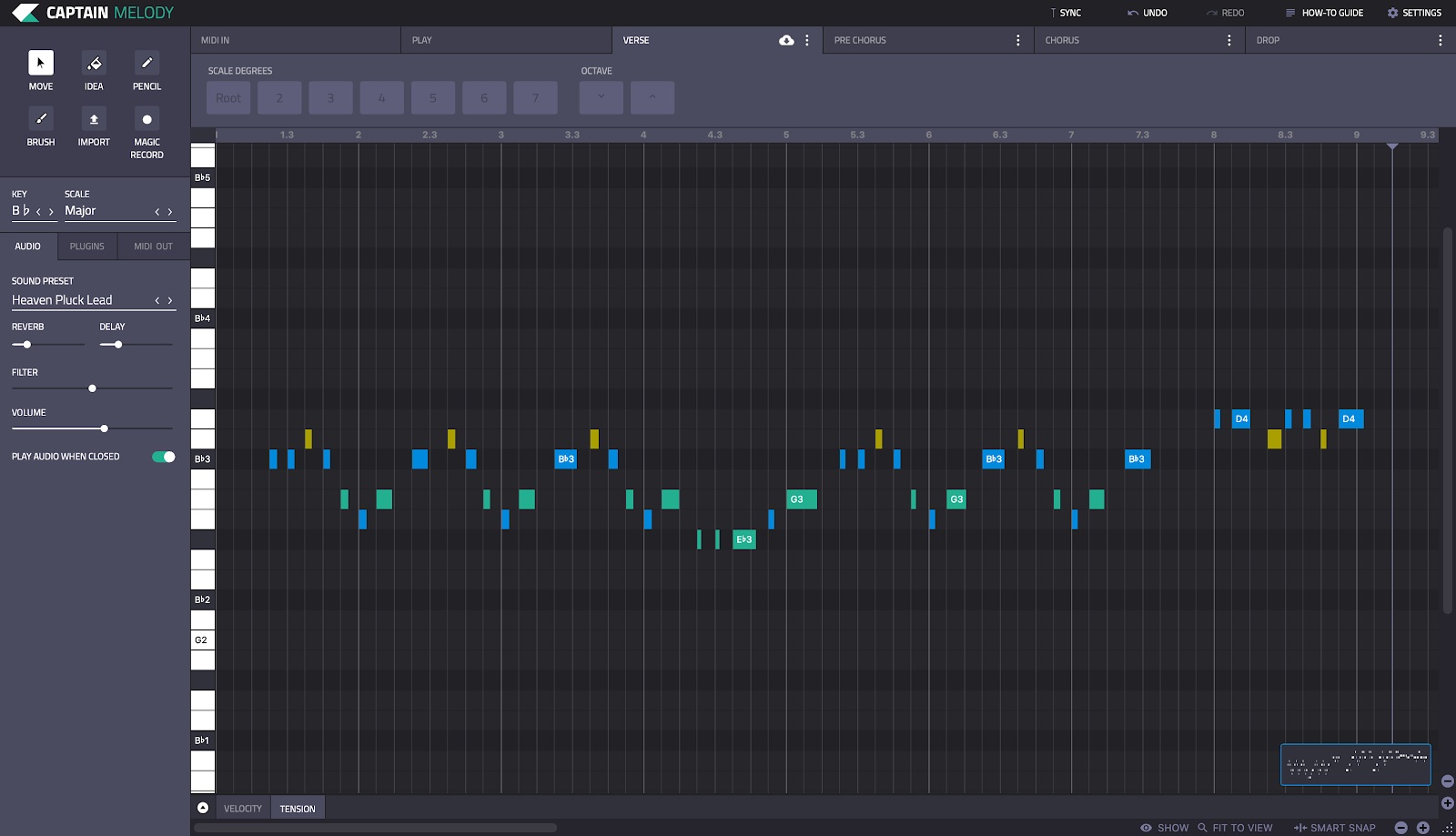Ultimate Tips for Writing Killer Melodies.
 Photo by SoundTrap on Unsplash
Photo by SoundTrap on Unsplash
There are few things more essential to your track than a strong melody – a feature that not only defines how memorable your track is going to be, but often acts as a calling card for your composition as a whole. But how do you write a strong melody? How do you tell when a melody is killer, or filler?
Daniel Hignell-Tully provides some welcome navigation through the waters of melody composition:
3 Functions of melodies.
Even for professional songwriters, it can sometimes seem like a good melody has a life of its own, growing organically from the ether. However, melodies tend to follow some surprisingly strict rules, and by learning them, you can make your tunes stand out from the crowd with some much-coveted melodic panache.
It can be tempting to consider them as simply a pleasant arrangement of notes. But melodies are more than that. They tend to have one of three functions, which we can broadly classify as grounding, orientation, and direction.
Grounding: Laying out the scale.
Nina Simone’s seminal ‘I put a spell on you’, opens with a slow meander through the notes of F-sharp Minor, setting the scale for the song to follow.
The melody oscillates between the first and third scale degree – Fsharp and A. Then, it moves up to an unexpected flat fifth (C). Repeating variations of this pattern continue before stepping down to a fifth below the root, and from there descending step by step through the scale. To add an extra level of melodrama, this descent doesn’t just return to the tonic, but instead passes it and concludes a full octave below its starting note. This might sound complicated, but its a fairly simple execution. The melody simply explores different ways of travelling from the root to the fifth, then back to the root once more.
Although the melody never actually repeats, its final four notes – the fifth, fourth, third, and first scale degree – recur multiple times. Subtly, they append the verses. By showing us the entirely of the song’s scale, and working through it with mostly small, stepwise motions, the melody serves as a kind of sonic map. It grounds the listener in the chosen scale and allows them to pre-empt many of the melodic and harmonic developments that follow. It’s a bona-fide killer melody, right?

Orientation: resolving complexity.
Melodies can also serve as a great way of orienting the listener within a composition, particularly as part of larger, more complex compositions. Clint Mansell’s ‘Lux Aeterna’ – despite being a relatively austere classical composition – contains one of the most instantly recognisable melodies of the last twenty years.
Featured in the film ‘Requiem for A Dream’ – and subsequently reused for blockbusters such as ‘Lord of the Rings’ and ‘Sunshine’ – the piece is a masterclass in melodic development. Alternating repeatedly between the first and last scale degree of B Flat Minor (B flat and A) – and articulating the first 2 beats of every bar – the melody slowly steps down the scale. It steadily increases the density of notes on every fourth bar. Rather than fully demonstrating the whole musical potential of his chosen scale, Mansell instead focuses on just a couple of notes at a time. This allows his pronounced use of rests to provide an alluring rhythmic structure.
Despite the wider harmonic complexity of the music as a whole, you need only listen to a few seconds of the piece to have a strong idea of where it’s heading. The melody persistently orientates the listener within the wider composition.
As the piece progresses, even dramatic shifts in instrumentation and structure are framed by such a simple melodic device that it perfectly balances emotional drama and economic clarity. Examples of this are the introduction of a full choir, and a doubling of the tempo. This dramatic clarity is exactly the reason it’s become such a mainstay of film trailers that need to convey maximum impact in minimal time.

Direction: maintaining momentum.
It can be helpful to consider a melody as a form of agreement between the listener and the composer. Both parties acknowledge the limited pool of notes available to any given scale, and the composer works to move through them in a manner that both fulfils the listeners expectations, and offers a degree of surprise along the way.
Arguably the most common form of melody, is the lead-line or vocal melody. Rather than directing the listener to qualities within the rest of the track, the lead-line instead cuts a path through the music. It provides a catchy, repetitive refrain that sticks in the memory. By way of example, Tove Lo’s ‘Habits’ walks up and down the mains notes of Bb major. Starting on the fifth scale degree (F), it steps up to the 6th (G) then down to the 3rd scale degree (D) at the end of each bar. Whilst the movement from the 5th to the 3rd is fairly commonplace, Lo keeps things interesting in two ways.
Firstly, the melody alternates between quarter notes and eighth notes, with the first bar comprising of more of the former, whilst the second bar contains more of the latter. Secondly, the first two beats of the bar are silent – the vocal melody starts on beat 3, and overhangs the broader song structure, with the singer’s final beat placed on the first beat of the following bar.
Vocal melodies serve as a great way of letting the listener know when a particular part of the song has reached its conclusion. In ‘Habits’, Lo introduces the 7th scale degree on the final bar of the verse, before using it – alongside the 3rd – as one of the dominant two notes of the chorus melody that follows.

The rules of a killer melody.
Whilst there are numerous ways of working with melodies, they often follow many of the same rules. You don’t need to follow them all, but they nonetheless serve as a useful checklist to help you write killer melodies.
- Focus on small, incremental steps. Don’t feel the need to jump wildly between different notes in the scale. Often movements in logical increments – such as moving from the third to the fifth – result in truly killer melodies.
- 1. Don’t be afraid to reach a climax! A strong melody might rely on small steps, but it will often counteract this with one or two wild, climatic leaps. This is particularly powerful around the chorus.
- 2. Differentiate between the verse and chorus. Melodies are a great way of ‘lifting’ up the core parts of your track. A heavier reliance on the tonic or fifth during the chorus, for instance, can elevate it from the verse. Likewise, higher pitches are often perceived as being more energetic. You can really put the ‘power’ in your ‘power ballad’ by raising the chorus an octave.
- 3. Embrace closure. Melodies are a great way of making your listener feel they have ‘arrived’ somewhere. Returning to the tonic can often help articulate the feeling that the melodic journey has concluded.
- 4. Use the melody to articulate the natural rhythm of the lyrics. Moving up or down the scale can alter the mood and context of the words of your song.
The melody is a journey, but if you’re always moving forward it will soon get boring. Don’t be afraid to repeat your footsteps, or even to double back on yourself – doing so will help cement your melody in the minds of your listener, and add further impact to the climax when it does finally arrive.
Working with Captain Melody.
Mixed in Key’s Captain Plugins have been developed specifically to help you write killer melodies. The interface gives you meaningful, hands-on control of all of the elements that we’ve discussed in the examples above. You can control the octave range, and the nature of the intervals between notes via the step and leap controls. The former offers small, stepwise movements, and the latter more exciting leaps. You can get even finer control of your melody by using the Rhythm and Lanes tabs.
Start by loading up an instance of Captain Melody in you DAW, and then use the Idea tool to create a basic melody in A minor. As with our examples above, the goal here is to create an interesting journey through the notes of our chosen scale. The melody is a good way of gently leading a listener along a path, so set the step value to around 50% and the leap value to 0. Every note in the pattern is now either one step up, or one step down from the previous note. Whilst this makes it easy for our listener to pre-empt what’s coming next, it is potentially a little unexciting. To rectify this, head over to the Leap parameter and rise it to around 20%.
You’ll notice now that our melody broadly follows the notes in A minor. Nonetheless, it includes a few more dramatic, unexpected jumps to notes much higher or lower in the scale. We can spice this up even further. Use the Rhythm tab to set both the number of notes (or density), and the number of rests. Play around until you get a good balance, with the rests providing a jaunty, but not too irregular groove.

Working with Captain Melody’s Lanes tool.
Now we have a nice pattern laid down, lets use the Lanes tab to do some of the fine-tuning we discussed above. Let’s make that melody a killer…
We know the third and the fifth scale degree are often the most recognisable, so select the first half of your pattern, and raise both their dials. Adjust the other parameters to taste, but make sure to leave the root dial at 0. Now select the second half of the pattern, and reduce both the third and fifth by about 50%. Raise the 7th scale degree instead.
Now highlight just the last handful of notes, and raise the root slider to around 80%. Since listeners most often hear the third and fifth scale degrees, they’ll likely find the first half fairly reassuring. It meets their expectations. However, we’ve kept things interesting by reducing such familiarity as the melody proceeds. By avoiding the root entirely until the last few notes, the pattern ends with a firm sense of resolution. The pattern has finally arrived at the expected destination.

With so many controls at your disposal, Captain Plugins allow you to fully explore your understanding of music theory. You can use it to produce a wide range of melodies suited to an infinite array 0f genres and purposes. By pre-empting your listener’s expectations – and knowing how to mess with them – you can write killer melodies with ease.
About the author:
